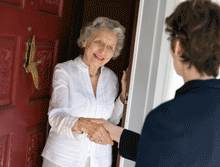Your Trusted Source For
Florida Voter Lists
Walking Works
 If a candidate in a small community wishes to win an election, walking is the single most important activity in which to engage. For any viable and physically mobile candidate, personal contact supercedes all other forms of vote-getting activities in a campaign. There is absolutely no better way to master your campaign pitch to your constituency. The side benefits include meeting some interesting people, and, maybe, become a little more physically fit.
If a candidate in a small community wishes to win an election, walking is the single most important activity in which to engage. For any viable and physically mobile candidate, personal contact supercedes all other forms of vote-getting activities in a campaign. There is absolutely no better way to master your campaign pitch to your constituency. The side benefits include meeting some interesting people, and, maybe, become a little more physically fit. Why Walking Works
There is an old adage in non-profit fundraising: people give to people, interpreted as, you are more likely to get a donation from someone if you are face-to-face with them rather than calling them, or less effective yet, mailing them a request for a donation.
The corollary for campaigns is that people vote for people, meaning you are more likely to get someone's vote if you are face-to-face with them, and walking is the best way to make this happen. Of course, the success of incorporating walking to actually generate the number of votes to win an election is dependent on the size of the electorate.
We are comfortable in stating that a viable candidate would have an impossible time losing an election in a town of less than 7,000 registered voters if he or she were committed to doing what it takes to win; i.e., walking every evening and Sunday afternoons for as long as possible prior to an election
The Future of Advocacy Walking
As yet, there is no perfect way to design a paper walk list that is foolproof or completely efficient. Nor has technology reached the point where we can use a computer rather than a paper walk list; but the technology is just around the corner.
After personally walking thousands of homes, technologically, we believe we know exactly what is required of a computerized walking device to walk efficiently.
The next level of advocacy walking, possibly not that far into the future, will be based on a lightweight touch screen tablet, about 8 in by 10 in, that contains the voter data and GPS capability. When you turn it on, it immediately positions your location in the center of the screen encircled by the network of streets around you. Street names are clear. Voter's homes are indicated on every street by small geographic figures shaped like houses. Apartment buildings are marked differently than houses. A narrow touch-screen menu bar spans the top or side of the tablet. There is an easy zoom button on the menu bar to open the screen to a greater or lesser elevation above your location showing more streets or fewer streets. You will need to place a marker on the map indicating where your car is parked: you will always need to return to it, so you need it coded on your map. As with the Apple ipod, you should have the ability to move the screen in any direction with your finger or some such “sticky” tool. A dotted line will track your movement on the street away from your car.
As you approach the first house on the street where you are parked, a stylus touching it will open a spreadsheet like smaller page which lists the voters in the residence along with the personal information normally available on each voter. If it is an apartment building, selecting the building will yield a list all all the apartments sorted by apartment number and the number of quality voters in each unit. The selection of any apartment will produce a list of the voters in the unit along with the personal information normally available for each voter.
A small button will open a third window which can be zoomed out for writing notes about the house or unit. Touching a voter line will open a window to allow writing notes about that specific voter. Closing the screen window will again allow you to see all the voters in the residence. Again, you can open a window that allows you to record, by character entry or stylus punch, facts like say, "no one was home." Close this window and you return to an aerial view of your location. Zoom out if you need to, in order to identify the next house on the block or around the corner.
The last addition would be to have your notes automatically emailed to campaign headquarters after “Saving.” This is so your work won’t be lost when your assistant accidentally drops the unit and it becomes a doorstop rather than a computer.
The device I described doesn’t yet exist. Even if a device that does all of the eventually becomes available, we fear making it lightweight and indestructible will be so costly that campaigns in the near future will not be able to afford it. We are afraid we are going to have to wait until another entity, most likely the Census Bureau, has a need for this same type device. Eventually, campaigns will reap the benefits of this technology.
Contact Us | Terms of Use | Privacy Policy | Site Map
Copyright © 2009 Campaign Data, Inc All Rights Reserved